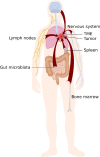Beyond the tumour microenvironment
- PMID: 30989643
- PMCID: PMC6766895
- DOI: 10.1002/ijc.32343
Beyond the tumour microenvironment
Erratum in
-
Erratum.Int J Cancer. 2021 Mar 15;148(6):E5. doi: 10.1002/ijc.33412. Epub 2020 Dec 3. Int J Cancer. 2021. PMID: 33319928 Free PMC article. No abstract available.
Abstract
In contrast to the once dominant tumour-centric view of cancer, increasing attention is now being paid to the tumour microenvironment (TME), generally understood as the elements spatially located in the vicinity of the tumour. Thinking in terms of TME has proven extremely useful, in particular because it has helped identify and comprehend the role of nongenetic and noncell-intrinsic factors in cancer development. Yet some current approaches have led to a TME-centric view, which is no less problematic than the former tumour-centric vision of cancer, insofar as it tends to overlook the role of components located beyond the TME, in the 'tumour organismal environment' (TOE). In this minireview, we highlight the explanatory and therapeutic shortcomings of the TME-centric view and insist on the crucial importance of the TOE in cancer progression.
Keywords: immune system; microbiome; nervous system; tumour microenvironment; tumour organismal environment.
© 2019 The Authors. International Journal of Cancer published by John Wiley & Sons Ltd on behalf of UICC.
Figures


References
Publication types
MeSH terms
Substances
LinkOut - more resources
Full Text Sources

